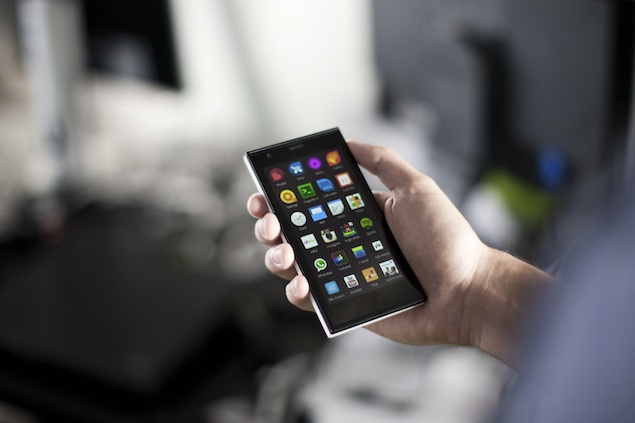The
"1 percent" is often used to disparage the American elites at the very
top of the wealth scale. When it comes to smartphones, however, the "1
percent" is the bottom of the heap.
Research firm Gartner says 94
percent of smartphones sales last year were either iPhones or Android
devices. Windows Phone and BlackBerry devices made up another 5 percent
combined.
What about the remaining 1 percent? They are the wannabes such as Firefox and Sailfish.
I
had a chance to try out some of these little-known systems at the
Mobile World Congress wireless show in Barcelona, Spain, this week. Many
of them aren't even available in the U.S., where I live. Although I
don't see myself replacing my Samsung Android phone even if I could,
some of these alternative phones have features I envy.
Firefox OS, from Mozilla
Firefox
is better known for its Web browser. Now, the people behind it are
trying to adapt it to run smartphones targeted at emerging markets.
Firefox
OS was launched last summer with three phones, priced around $50 to
$70. They are available in 15 countries, but not in the U.S.
At
the Barcelona show, Mozilla unveiled plans to expand to additional
markets in Latin America and eastern Europe, while ZTE announced two new
models. Chipmaker Spreadtrum Communications Inc. also announced a
blueprint for any phone maker to make $25 smartphones using Firefox OS.
The home screen and icons resemble what's found on iPhones and Android.
Where
Firefox OS starts to differ is in apps. With iPhones and Android, you
go to an app store to get new apps. With Firefox OS, you typically have
instant access to all apps, the same way you can visit a website for the
first time without installing anything.
The catch is you need an
Internet connection to use apps that aren't on your phone, but many apps
need that access anyway to refresh news, social networks or restaurant
guides.
Firefox OS also has a universal search for all content on the phone and online.
There's
another neat feature coming to Firefox OS. Swipe from the left side of
the screen to flip through recent apps one by one, just like hitting the
back button on a Web browser.
Sailfish OS, from Jolla
Sailfish
is based on the Linux operating system and comes from the Finnish
company Jolla (pronounced "yolla"). Former Nokia employees created Jolla
after that struggling cellphone maker abandoned an in-house operating
system in favor of Microsoft's Windows Phone.
There's only one
phone out so far, and it's sold only in Europe for 399 euros ($546). But
Jolla has ambitions to reach Russia and Asia and to partner with other
phone makers.
Jolla Ltd. also announced last week that it will
release a free app that Android users can install to replace the regular
Android interface with Sailfish's.
I can see getting the hang of
Sailfish over time. It emphasizes gestures over tapping. You can access
many functions by swiping from an edge on the screen.
The home
screen has nine large rectangles, similar to an elongated tic-tac-toe
board. These are filled with up to nine of your open apps, so you can
instantly get to any one.
You can tap to open an app, but what's
neat is you can reach a task directly by pressing gently on the
rectangle and dragging your finger. For the mail app, drag from the left
to create a message, or drag from the right to refresh messages. For
the phone app, drag from the left to get the dialer, or drag from the
right to get your list of contacts.
This saves time once you get used to the gestures.
To
close an app, you can swipe down from the top edge like a window shade.
If you're already on the home screen, swipe down to lock the phone.
Apple introduced similar gesture controls with its iOS 7 update last fall, but Sailfish goes much further.
There
aren't many apps written for Sailfish yet, but Sailfish phones have a
special tool for running most Android apps. You won't get some of the
gesture functions, though.
Ubuntu, from Canonical
Like
Sailfish, Ubuntu is based on Linux. Unlike Sailfish, there aren't any
Ubuntu phones yet. But the company behind it announced partnerships with
two phone makers last week. Phones are due to come out this year,
likely to European and Asian markets first.
Ubuntu's home page has
a series of so-called scopes, arranged by category. One video scope
might consist of icons for movies on your phone. Another might have
items in your Netflix queue. You can refine what's presented through a
universal search. The idea is to let you access content easily, without
having to open an app first.
Swipe from the left edge to get a
launcher. The top has all your open apps, while your favorite apps are
underneath those. There's also a home screen scope to search for
installed apps and those in the app store.
Swipe from the right
edge to get your most recently used app. Swipe further for a carousel of
all open apps. Just pick one to go straight to it.
These systems
all have good innovations to help users, but people will find the phone
and app selections quite limiting. Sailfish has potential if it can run
well on existing Android phones, while Android apps can run on it. I
look forward to trying that out when it's released in the first half of
the year.

MWC 2014 in pictures
For the latest tech news and reviews, follow Gadgets 360 on X, Facebook, WhatsApp, Threads and Google News. For the latest videos on gadgets and tech, subscribe to our YouTube channel. If you want to know everything about top influencers, follow our in-house Who'sThat360 on Instagram and YouTube.
Further reading:
Android,
Apple,
BlackBerry,
Canonical,
Firefox OS,
Jolla,
Mobiles,
Mozilla,
Mozilla OS,
Sailfish OS,
Ubuntu,
iOS,
MWC,
MWC 2014,
MWC2014
 Google to Host Dedicated 'Android Show' Ahead of I/O 2025 Developer Conference Next Month29 April 2025
Google to Host Dedicated 'Android Show' Ahead of I/O 2025 Developer Conference Next Month29 April 2025 Google Settles India's Antitrust Probe in Android TV Case21 April 2025
Google Settles India's Antitrust Probe in Android TV Case21 April 2025 Android 16 Beta 4 Update Reportedly Modifies Clock Font on Pixel Phones; AOD Clocks Get Dynamic Colour21 April 2025
Android 16 Beta 4 Update Reportedly Modifies Clock Font on Pixel Phones; AOD Clocks Get Dynamic Colour21 April 2025 Google Pixel 9a Is Now Eligible for Android 16 Beta Programme18 April 2025
Google Pixel 9a Is Now Eligible for Android 16 Beta Programme18 April 2025 WhatsApp Rolls Out New Feature Which Lets Users Create, Organise and Share Custom Sticker Packs18 April 2025
WhatsApp Rolls Out New Feature Which Lets Users Create, Organise and Share Custom Sticker Packs18 April 2025

![Gadgets 360 With Technical Guruji: News of the Week [April 26, 2024]](https://c.ndtvimg.com/2025-04/5ucuv89c_news-of-the-week_160x120_26_April_25.jpg?downsize=180:*)












